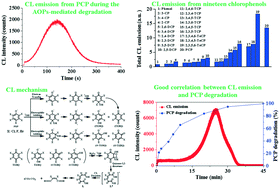Molecular mechanisms and potential applications of the intrinsic chemiluminescence produced from the degradation of haloaromatic pollutants during environmentally-friendly advanced oxidation processes
Abstract
The ubiquitous distribution of halogenated aromatic compounds (XAr) coupled with their carcinogenicity has raised public concerns over their potential risks to both human health and our ecosystem. Recently, advanced oxidation processes (AOPs) have been considered as an “environmentally-friendly” and green technology for the degradation of such recalcitrant and highly toxic XAr. During the course of our study on metal-independent generation of hydroxyl radicals (˙OH) by halogenated quinones and H2O2, we found, unexpectedly, that an unprecedented ˙OH-dependent intrinsic chemiluminescence (CL) can be produced by H2O2 and polyhalogenated quinones. Further investigations showed that, in all ˙OH-generating AOPs, CL can also be produced not only by pentachlorophenol and all other halogenated phenols, but also by all XAr tested. A systematic structure–activity relationship study for all nineteen chlorophenol congeners showed that the CL increased with an increase in the number of chlorine-substitutions in general. More importantly, a relatively good correlation was observed between the formation of quinoid/semiquinone radical intermediates and CL emission. Moreover, for those halogenated hydroxy-quinoid pollutants, much stronger CL emission and better degradation could be induced by cobalt(II)-mediated Fenton-like systems, and ˙OH produced site-specifically was found to be responsible for this unusual CL emission. On the basis of these results, a rapid, sensitive, simple, and effective CL-based analytical method was developed not only to measure and quantify trace amounts of XAr and related haloquinoid compounds, but also to monitor their degradation kinetics and provide useful information for predicting their toxicity. These findings may have broad chemical, environmental and biological implications for future studies on halogenated aromatic persistent organic pollutants.

- This article is part of the themed collection: Drinking water oxidation and disinfection processes


 Please wait while we load your content...
Please wait while we load your content...